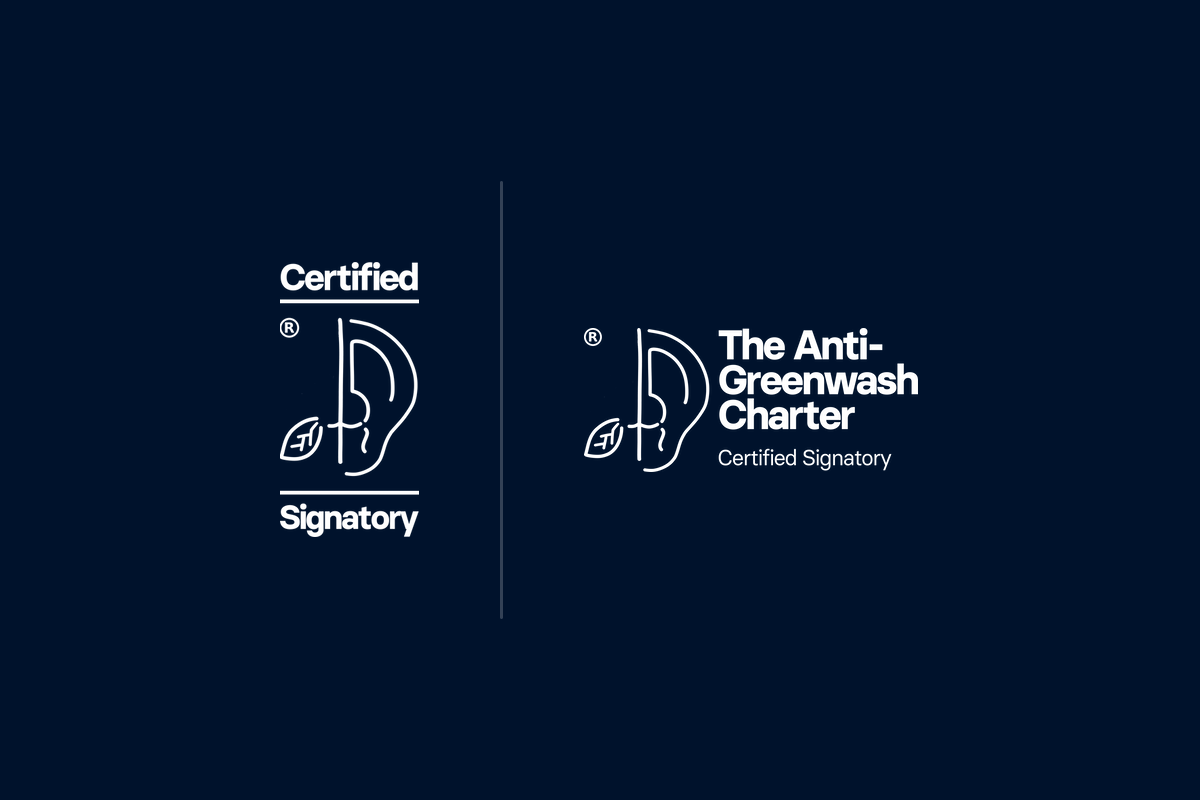What It Really Means to Be a Signatory of The Anti-Greenwash Charter

What It Really Means to Be a Signatory of The Anti-Greenwash Charter.
Date: December 2024
Read time: 5 mins
Author: Charlie Martin
In a world where sustainability claims are under increasing scrutiny, being a signatory of The Anti-Greenwash Charter isn’t just about displaying a badge. It’s a commitment to transparency, accountability, and continuous improvement. The Charter’s structured process ensures organisations communicate their environmental efforts responsibly and credibly, while also providing the tools to strengthen their practices.
But what does it really mean to be a signatory? Here’s an in-depth look at the journey, the responsibilities, and the rewards of joining the Charter.
More Than a Commitment: A Collaborative Journey
Becoming a signatory starts with a simple but rigorous application process. The Charter’s revised framework is designed to guide organisations step-by-step, ensuring they achieve and maintain the highest standards of sustainability communication.
Step 1: Application & Assessment
The journey begins with a thorough evaluation of an organisation’s history and practices. This isn’t a box-ticking exercise—it’s a robust process designed to establish a foundation for improvement.
What’s involved?
- Regulatory History Check: Organisations are reviewed for any upheld cases with key regulatory bodies like the Advertising Standards Authority (ASA) or Competition and Markets Authority (CMA) within the last five years.
- Media Coverage Review: Independent research identifies any instances of potential greenwashing in publicly available materials.
- Practice Analysis: Current communication practices are assessed to determine their transparency and alignment with the Charter’s standards.
For international applicants, this process is adapted to their local regulatory context, ensuring fairness and relevance.
Why it matters:
As Chris Brookman, Founder of Back to Earth, explains:
“We spend a lot of time researching and investigating the products we sell. Seeing the claims made by some companies… made us want to define ourselves and give consumers confidence in our communications.”
Organisations that pass this phase demonstrate a genuine commitment to ethical practice and move on to the development phase.
Step 2: Development & Approval
This is where the real transformation begins. Over six months, organisations receive tailored support to align their practices with the Charter’s standards.
What’s involved?
- Materials Review: Existing communications are evaluated, with detailed feedback to address any gaps or risks.
- Tailored Training: Teams are equipped with anti-greenwashing training to ensure they understand and can apply best practices.
- Green Claims Policy (GCP): A bespoke policy is developed, covering:
- Governance structures for accountability.
- Clear, standardised language to avoid misrepresentation.
- Evidence-backed claims that reflect the full lifecycle impact of products or services.
Once the GCP is finalised, the organisation achieves verified signatory status.
Why it matters:
For signatories like Karndean Designflooring, this phase is transformative. Jamie Shaw, Global Head of Sustainability, notes:
“The Charter has shown us that it’s not just about words; we also need to be mindful of the imagery and colours we use when discussing our sustainability claims.”
The result is a comprehensive marketing and communications strategy that builds trust and credibility.

Step 3: Campaign Reviews & Support
Verification is not the end of the journey—it’s the beginning of a long-term commitment.
What’s involved?
- Spot Checks: Regular reviews of campaigns ensure ongoing alignment with the GCP. Evidence such as campaign assets, policies, or supporting records are reviewed for compliance.
- External Concerns: Any concerns raised about a signatory’s campaigns are investigated, ensuring accountability.
- Review Outcomes: Campaigns are assessed as:
- Compliant
- Compliant with Recommendations (minor improvements suggested)
- Non-Compliant (requiring corrective action to maintain signatory status)
Non-compliance must be resolved promptly, with repeated issues potentially resulting in suspension or loss of verified status.
Why it matters:
As Kelsey Parsons, Global Sustainability Officer at Gunnebo Entrance Control, puts it:
“For us, authentic sustainability is all about evidence. It’s not just about claiming progress; it’s about showing facts to back it up.”
This ongoing accountability ensures that signatories maintain their credibility and continue to uphold the highest standards.
What It Means Day-to-Day
Being a signatory means embedding transparency into every aspect of sustainability communications. It’s about asking hard questions internally, being open to feedback, and continuously improving.
For Catherine Clarkson, Head of Marketing & Strategy at Sentry Doors, the journey has been foundational:
“Our journey in Environmental, Social, and Governance (ESG) is just beginning, and we’re committed to transparency throughout this process.”
Signatories often find that the Charter’s principles ripple outward, influencing not just their marketing and communications but their entire approach to sustainability.
The Rewards of Being a Signatory
Becoming a signatory is not without its challenges, but the rewards are significant:
- Enhanced Trust: Consumers, stakeholders, and regulators can trust that your claims are backed by evidence.
- Reputation Building: Demonstrating accountability strengthens your brand’s reputation as a leader in responsible communication.
- Risk Mitigation: The structured process reduces the risk of greenwashing accusations and legal repercussions.
Tom Bourne, Creative Director at Select First, sums it up:
“Manufacturers know they must talk about sustainability and green issues, so many seem to be looking for a ‘hook’ that makes them look good, at the compromise of honesty and transparency.”
By becoming a signatory, organisations choose authenticity over shortcuts.














